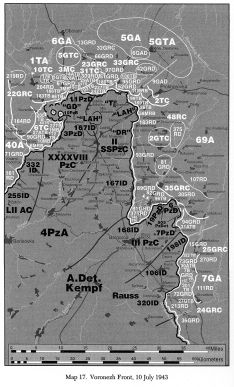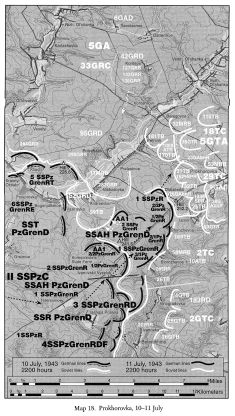As you know, a battle has spatial and temporal limits, which are defined by the beginning and the end of achievement of particular objectives of the operation. The Germans started to fulfill their mission to advance into the rear defensive line and capture Prokhorovka on July 10th. Our forces were fighting off their attempts to reach the town. Therefore, it is appropriate to consider the beginning of the battle as July 10th.
 During the night of July 17th
the enemy command started pulling out its forces from the front lines towards
Belgorod-Pomarovka, this way, the 4th PzA abandoned its attempts to capture
Prokhorovka and switched its attention to another operational goal - retreat
of the forces to the previous lines. Respectively, the mission of our forces
also changed. This allows to claim that the Prokhorovka battle ended on July
16th, with its climax taking place on July 12th, when the last large mobile
reserve of the Front - the 5th GTA entered the battle.
During the night of July 17th
the enemy command started pulling out its forces from the front lines towards
Belgorod-Pomarovka, this way, the 4th PzA abandoned its attempts to capture
Prokhorovka and switched its attention to another operational goal - retreat
of the forces to the previous lines. Respectively, the mission of our forces
also changed. This allows to claim that the Prokhorovka battle ended on July
16th, with its climax taking place on July 12th, when the last large mobile
reserve of the Front - the 5th GTA entered the battle. These chronological boundaries allow to accurately determine the place of this battle in the Battle for Kursk and the war as a whole. Without underestimating the role and achievements of the 5th GTA, we can more objectively determine the correlation of forces in the battle, give proper credit to the participants, and most importantly - realistically analyze the results.
Up until July 10th all the attention of the Voronezh Front's command was concentrated on the Oboiani direction. During the night of July 9th the 10th TC of Lieutenant-General V.P. Burko under the direct orders of N.F. Vatutin left the Prokhorovka region in order to be incorporated into the defenses of the 1st TA. At 2200 July 8th Vatutin also ordered to transfer the 5th "Stalingrad" TC of General A.G. Kravchenko from the region of "Komsomolets" - Iasnaia Poliana - Teterevino to the operational command of M.S. Katukov. For better operational command on the Prokhorovka and Korochan directions General N.F. Vatutin united the leadership of all the forces under the command of the 69th A of Major-General V.D. Kruchenkin. This army had the mission of defending the frontline along Vasilevka - Shopino - Belomestnoe - Kiseleve - Shliakhovo - Miasoedovo. To fulfill this mission the army commander had 9 rifle divisions, one tank corps, one tank brigade, one tank regiment, two artillery brigades, and several antitank-destroyer artillery regiments.
Still, the departure of a tank corps obviously weakened the defenses south-west of Prokhorovka. At this sector by July 10th remained only the 183rd Rifle Division of Major-General A.S. Kostitsin. To the right, in the bend of Psel, by July 7th the positions were occupied by the 52nd GRD of Colonel I.M. Nekrasov of the 6th GA. The gap between these two divisions in the region of the village Krasnyi Oktyabr - Andreevka was defended by the 11th Motorized Rifle Brigade of Colonel Borodin of the 10th TC. The fate of this unit was not a easy one. Having occupied the defensive positions at the Prokhorovka direction on July 6th, the brigade was continuously engaged in fighting for five days. It also actively participated in the counterattack on July 12th. Its soldiers and junior officers fought tenaciously against the SS units, causing them sensible losses, but most importantly, not once during these days did the enemy manage to break through their defenses. However, after the war nobody remembered this unit because of the Prokhorovka tank battle.
The only mention of this unit that I have found was in a book published by the General Staff in 1946 intended to study the experience of the past war. That book was intended for the military audience and was not available to the general public. Today, for the first time, I'd like to pay respect and remembrance to the soldiers of that brigade - the active participants of the Prokhorovka battle.
The 183rd RD was supported by the 2nd TC that arrived from the South-Western Front on July 8th. Because of a lack of auto-transport, the tank brigades reached Prokhorovka first. The 58th MRB moved on foot and arrived only on the morning of July 11th. Some scholars condemn N.F. Vatutin in an incorrect analysis of the situation on the Prokhorovka direction that developed by July 10th. The Germans concentrated here their best tank formations, and the Front commander transferred two tank corps to General M.E. Katukov, obviously weakening 69th Army's defenses. Undisputably, this is true. Especially if we consider that the bend of the river Psel was the junction between the two armies 6th Guards and 69th A's, a sector always considered to be most vulnerable in any form of defense. The total manpower of the defending units was also small: 285th RR of the 183rd RD had 1508 men, 11th MRB - 1444 men, and 52nd GRD - 3380 men.
 But we have to understand the
Front commander as well. Firstly, the redeployment of the 2nd SSPzC was conducted
quickly and secretly, under the cover of strong attacks. Because of this, our
reconnaissance did not notice the redeployment on time. The Front command could
only guess, analyzing the situation and the enemy's moves, that the Germans
could change the direction of the attack. Such a guess was voiced on July 10th
by A.M. Vasilevsky in a conversation with A.S. Zhadov at the Front headquarters.
But we have to understand the
Front commander as well. Firstly, the redeployment of the 2nd SSPzC was conducted
quickly and secretly, under the cover of strong attacks. Because of this, our
reconnaissance did not notice the redeployment on time. The Front command could
only guess, analyzing the situation and the enemy's moves, that the Germans
could change the direction of the attack. Such a guess was voiced on July 10th
by A.M. Vasilevsky in a conversation with A.S. Zhadov at the Front headquarters.
The most important task at that moment was to stop the Germans at the sector of the 6th GA, and if the enemy penetrated at the Prokhorovka direction, the two guards armies were already on their way. The main natural obstacle for the Germans' advance northwards was river Psel. Its width was relatively small - 10-15m. But the wide swampy banks, reaching up to 200m on both sides, presented a serious obstacle for the tanks. Therefore, during the night of July 10th the panzergrenadiers of the "Totenkopf," having crossed the river, attempted to establish a bridgehead on the right bank, in order to allow the engineers to build a pontoon bridge for the tanks. This attempt was repelled by the parts of the 52nd GRD, and also the artillery of the 11th MRB firing from the region of the Vasilevka and Andreevka. To liquidate this flanking fire at 0530 in the morning the Germans with a force of up a battalion of infantry and the support of ten tanks attacked these villages. Such a development was expected by the 2nd TC command. During the night of July 10th the reconnaissance reported about a concentration of enemy armor near Molozhavaya, and a prisoner from the 3rd regiment of the "Totenkopf" captured near the s.f. "Komsomolets" told about the latest order to attack Vasilevka the next morning.

